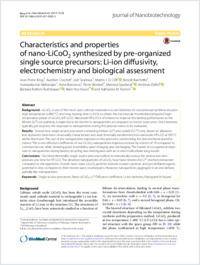Characteristics and properties of nano-LiCoO2 synthesized by pre-organized single source precursors: Li-ion diffusivity, electrochemistry and biological assessment
- Brog, Jean-Pierre Department of Chemistry, University of Fribourg, Switzerland
- Crochet, Aurélien Fribourg Center for Nanomaterials FriMat, University of Fribourg, Switzerland
- Seydoux, Joël Department of Chemistry, University of Fribourg, Switzerland
- Clift, Martin J. D. Adolphe Merkle Institute, University of Fribourg, Switzerland
- Baichette, Benoît Department of Chemistry, University of Fribourg, Switzerland
- Maharajan, Sivarajakumar Department of Chemistry, University of Fribourg, Switzerland
- Barosova, Hana Adolphe Merkle Institute, University of Fribourg, Switzerland
- Brodard, Pierre College of Engineering and Architecture of Fribourg, University of Applied Sciencesof Western Switzerland, Fribourg, Switzerland.
- Spodaryk, Mariana Laboratory of Materials for Renewable Energy (LMER), ISIC?SB, École Polytechnique Fédérale de Lausanne (EPFL), Valais/Wallis Energypolis, Sion, Switzerland
- Züttel, Andreas Laboratory of Materials for Renewable Energy (LMER), ISIC?SB, École Polytechnique Fédérale de Lausanne (EPFL), Valais/Wallis Energypolis, Sion, Switzerland
- Rothen-Rutishauser, Barbara Adolphe Merkle Institute, University of Fribourg, Switzerland
- Kwon, Nam Hee Department of Chemistry, University of Fribourg, Switzerland
- Fromm, Katharina M. Department of Chemistry, University of Fribourg, Switzerland
-
22.08.2017
Published in:
- Journal of Nanobiotechnology. - 2017, vol. 15, p. 58
English
LiCoO₂ is one of the most used cathode materials in Li-ion batteries. Its conventional synthesis requires high temperature (>800 °C) and long heating time (>24 h) to obtain the micronscale rhombohedral layered high-temperature phase of LiCoO₂ (HT-LCO). Nanoscale HT-LCO is of interest to improve the battery performance as the lithium (Li⁺) ion pathway is expected to be shorter in nanoparticles as compared to micron sized ones. Since batteries typically get recycled, the exposure to nanoparticles during this process needs to be evaluated.
- Faculty
- Faculté des sciences et de médecine
- Department
- Département de Chimie
- Language
-
- English
- Classification
- Chemistry
- License
-
License undefined
- Identifiers
-
- RERO DOC 305659
- DOI 10.1186/s12951-017-0292-3
- Persistent URL
- https://folia.unifr.ch/unifr/documents/306170
Statistics
Document views: 129
File downloads:
- pdf: 186
